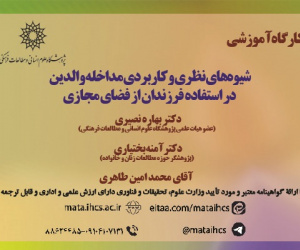تحلیل فضایی شاخص های سرزندگی با تأکید بر معابر شهری در کلان شهر مشهد (مقاله علمی وزارت علوم)
درجه علمی: نشریه علمی (وزارت علوم)
آرشیو
چکیده
در دهه های اخیر، به دنبال گسترش بی رویه شهرها و اهمیت روزافزون اتومبیل، نقش معابر شهری در فضاهای شهری کمتر شده است که این امر سبب ایجاد محیط های کسل کننده در شهرها و کاهش سرزندگی فضاهای شهری شده است؛ از این رو، سرزندگی معابر شهری یکی از مهم ترین دغدغه های برنامه ریزان شهری است. هدف این پژوهش تحلیل فضایی شاخص های سرزندگی با تأکید بر معابر شهری در سطح مناطق 13گانه کلان شهر مشهد است. پژوهش حاضر به لحاظ هدف از نوع کاربردی و به لحاظ ماهیت و روش از نوع مطالعه توصیفی همبستگی و روش گردآوری اطلاعات نیز اسنادی (کتابخانه ای) و میدانی (پرسشنامه) است. برای تجزیه وتحلیل داده ها و اطلاعات از SPSS و روش های تصمیم گیری چند معیاره مانند MEREC و COCOSO و روش معادلات ساختاری (Smart PLS) بهره گرفته شده است. نتایج پژوهش نشان می دهد مناطق 9، 1 و 4 بهترتیب دارای بالاترین و مناطق 3، 12 و 10 دارای پایینترین سطح برخورداری از شاخص های سرزندگی با تأکید بر معابر شهری، در شهر مشهد هستند. بر اساس نتایج آزمون معادلات ساختاری PLS، متغیر فراغت و تفریح با ضریب تأثیر کل 658/0 بیشترین تأثیر را بر سرزندگی با تأکید بر معابر شهری داشته است و سپس، بهترتیب مؤلفه های راحتی و آسایش (652/0)، جذابیت و تنوع کالبدی بصری (631/0)، کیفیت کالبدی (623/0)، ایمنی و امنیت (430/0) و دسترسی (160/0) مؤثر بر سرزندگی با تأکید بر معابر شهری هستند.متن
Spatial analysis of vitality indicators with emphasis on urban roads in Mashhad metropolis
In recent decades, following the excessive expansion of cities and the increasing importance of automobiles, the role of urban streets in urban spaces has decreased, which has led to the creation of boring environments in cities and the reduction of the vitality of urban spaces. Therefore, the vitality of urban streets is one of the most important concerns of urban planners. The purpose of this research is to spatially analyze the vitality indicators with an emphasis on urban streets in the ۱۳ regions of the Mashhad metropolis. The present research is of an applied type in terms of purpose and a descriptive-correlation study in terms of nature and method, and the data collection method is documentary (library) and field (questionnaire). SPSS and multi-criteria decision-making methods such as MEREC and COCOSO and the structural equation method (Smart PLS) have been used to analyze data and information. The study results show that regions ۹, ۱, and ۴ have the highest, and regions ۳, ۱۲, and ۱۰ have the lowest levels of vitality indicators with an emphasis on urban roads in Mashhad. Based on the results of the PLS structural equation testing, the leisure and recreation variable with a total impact coefficient of ۰.۶۵۸ has the greatest impact on vitality with an emphasis on urban roads. Then, the components of comfort and convenience (۰.۶۵۲), visual physical attractiveness and diversity (۰.۶۳۱), physical quality (۰.۶۲۳), safety and security (۰.۴۳۰), and accessibility (۰.۱۶۰) are effective on vitality with an emphasis on urban roads, respectively.











